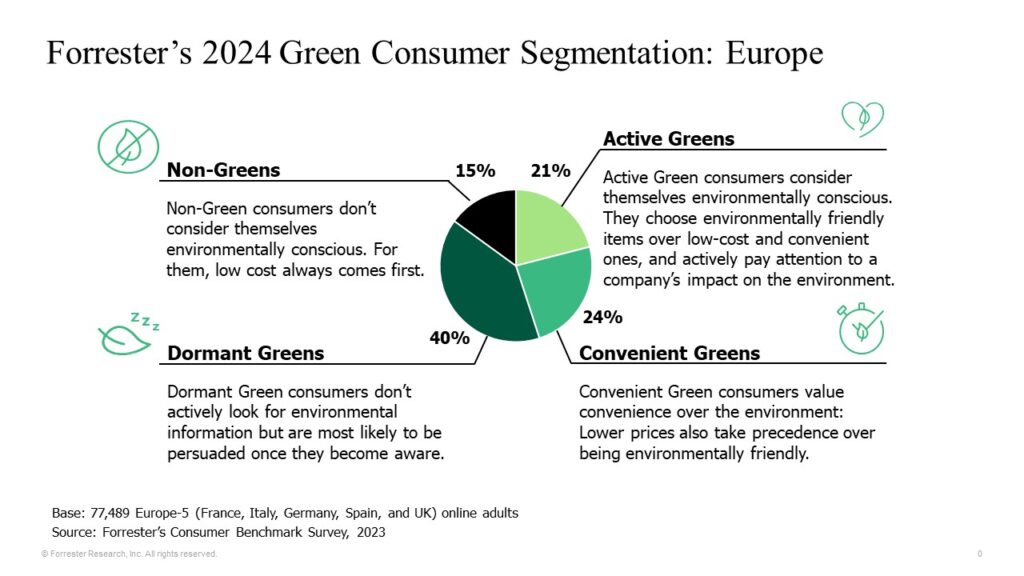European Consumers Challenge Popular Stereotypes About Greenness
(coauthored by Forrester Senior Research Associate Victoria Manes)
In Europe, a tough economic and geopolitical context is contributing to increasingly polarized discussions on the environment. European consumers are forming four distinct groups with regard to how their consumption habits impact both the environment and their daily lives:

Country-Level Stereotypes No Longer Apply: Southern Europe Leads In Green Consumers
While Europe’s green segments may look homogeneous, consumers’ behaviors and attitudes vary between countries. One popular belief is that German consumers are the greenest while those in Southern Europe lag behind. Our data indicates that it’s time to revisit these stereotypes:
- Italian consumers are among the greenest. Italy has the highest percentage of Active Greens and the lowest percentage of Non-Greens, followed by Spain and France. Italy has the highest air pollution in Europe and is one of the EU countries that has suffered the most from recent heat waves.
- Spanish consumers are enthusiastic about green products. Spanish online adults are the most likely among the five largest European economies to be willing to pay more for environmentally friendly products. A majority would like to understand how their purchases impact the environment and feel disappointed when they find out packaging isn’t recyclable or compostable.
- French consumers are more likely to be Dormant Greens. While French online adults are primarily Dormant Greens, only one in five French online adults think that reducing their environmental impact is too much work.
- German and UK consumers’ green behaviors and attitudes lag. Germany has the highest percentage of Non-Greens and second-lowest percentage of Active Greens after the UK. While brands that engage with UK consumers shouldn’t ignore green solutions, they must be aware of local behaviors and attitudes. UK consumers are the most likely to agree that they prefer cheaper products to environmentally friendly ones.
Beware Age-Related Stereotypes: Older Generations Are Far Greener Than You Might Think
Forrester’s green segmentation shows that the correlation between age and green behaviors and attitudes is partly true globally. But this is far from obvious in Europe, where sustainability and climate change rank higher on political and social agendas and green behaviors have spread rapidly across all generations. Our data reveals that:
- Gen Z isn’t the most actively green generation. Businesses and the media tend to typecast Gen Zers (born between 1997 and 2012) as the sustainability generation — a stereotype that’s reinforced by the hype surrounding young activists such as Greta Thunberg. Gen Zers’ relationship with environmental sustainability, however, is more nuanced than these lazy assumptions suggest: They value environmental awareness but expect seamless, instant experiences; they demand sustainable products but are the prime buyers of fast fashion; and they’re most likely to agree that a low-cost or convenient product is more valuable to them than an eco-friendly one.
- Older generations tend to be Active Greens rather than Convenient Greens. While older generations contain more Non-Greens, the key difference is the distribution between Active and Convenient Greens. The percentage of Active Greens among the Silent Generation is significantly higher than among Gen Zers. Why? Older generations have the time and money to act on the values that their children and grandchildren have instilled in them.
Clients who want to better understand consumers’ green behaviors and attitudes can read a series of brand-new reports below and can also schedule a conversation with me to go into the details of what it all means for them.
Forrester’s 2024 Green Consumer Segmentation: Europe
The State Of The French Shopper And Environmental Sustainability, 2024
The State Of The Italian Shopper And Environmental Sustainability, 2024
The State Of The UK Shopper And Environmental Sustainability, 2024
